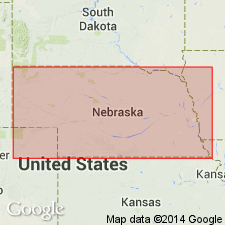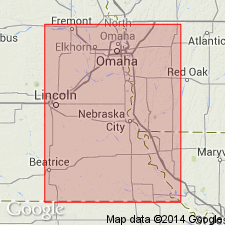
- Usage in publication:
-
- Rulo limestone member
- Modifications:
-
- Original reference
- Dominant lithology:
-
- Limestone
- AAPG geologic province:
-
- Forest City basin
Summary:
Pg. 8, 14, 26. Rulo limestone, basal member of Nemaha formation. Light-colored hard massive limestone, 12 to 20 inches thick, lying 8 to 12 feet below Burlingame limestone and overlying City Bluffs (Scranton) shales. Age is Pennsylvanian. Report includes measured sections, cross sections.
Type locality: 2.5 mi north of Rulo, Richardson Co., southeastern NE.
Source: US geologic names lexicon (USGS Bull. 896, p. 1559); GNC KS-NE Pennsylvanian Corr. Chart, sheet 1, Oct. 1936; supplemental information from GNU records (USGS DDS-6; Denver GNULEX).

- Usage in publication:
-
- Rulo limestone bed
- Modifications:
-
- Revised
- AAPG geologic province:
-
- Forest City basin
Summary:
Pg. 40, 41, 58, 105, 106. Rulo limestone bed of Scranton shale member of Shawnee formation. Included in Scranton shale his Rulo limestone and the shale (named Silver Lake shale) separating it from overlying Burlingame limestone; and this classification was adopted by R.C. Moore and G.E. Condra in their Oct. 1932 revised classification chart of Pennsylvanian rocks of Nebraska and Kansas. Condra's 1927 publication stated that Elmo-Silver Lake coal is just below Rulo limestone. Age is Late Pennsylvanian (Missouri age). Report includes cross sections, measured sections, geologic maps, stratigraphic tables.
Source: US geologic names lexicon (USGS Bull. 896, p. 1855); GNC KS-NE Pennsylvanian Corr. Chart, sheet 1, Oct. 1936; supplemental information from GNU records (USGS DDS-6; Denver GNULEX).

- Usage in publication:
-
- Rulo limestone member*
- Modifications:
-
- Revised
- AAPG geologic province:
-
- Forest City basin
Summary:
Pg. 2274 (fig. 1), 2277. Rulo limestone member of Scranton shale. Rank reduced to member status in Scranton shale, here reintroduced as a formation with stratigraphic span as assigned to it by Haworth and Bennett (1908). Underlies Silver Lake shale member; overlies Cedar Vale shale member. Age is Late Pennsylvanian (Virgilian).
Source: US geologic names lexicon (USGS Bull. 1200, p. 3357).
For more information, please contact Nancy Stamm, Geologic Names Committee Secretary.
Asterisk (*) indicates published by U.S. Geological Survey authors.
"No current usage" (†) implies that a name has been abandoned or has fallen into disuse. Former usage and, if known, replacement name given in parentheses ( ).
Slash (/) indicates name conflicts with nomenclatural guidelines (CSN, 1933; ACSN, 1961, 1970; NACSN, 1983, 2005, 2021). May be explained within brackets ([ ]).

